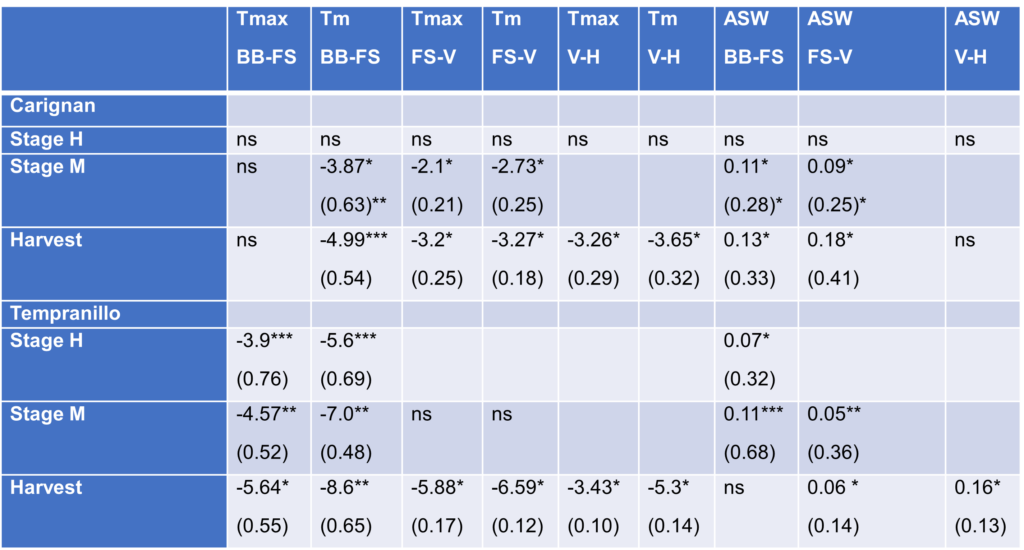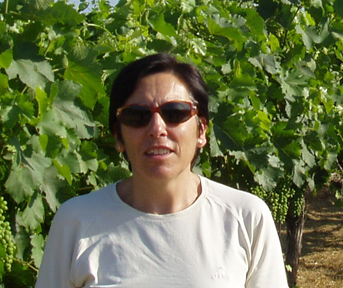By María Concepción Ramos y Fernando Martínez de Toda Fernández
Background and Objective
There is growing concern about the effects that a climate change may have on grape production and quality. This has led to studies carried out in different wine-growing areas of the world in which a trend of advance of phenology and harvest has been seen. However, the degree of change may not be the same in all areas and for all varieties. Given the projected climate change scenarios that involve changes in temperatures and in precipitation, it is necessary to deepen the knowledge of the response of different varieties to these changes and identify those varieties that may be more resilient, in addition to adopting other measures that can help mitigate the effects of warming.
La Rioja is one of the most traditional wine-growing areas in Spain in which red varieties are mainly grown, but also some white varieties, under the qualified designation of origin (DOCa) Rioja. Among the red varieties, Tempranillo is the majority variety, being accepted and cultivated in a much smaller proportion other varieties such as Garnacha, Mazuelo (Carignan) or Graciano. All these varieties are well adapted to the climatic conditions of the DO, but the following questions arise:
Do they all respond to changes in temperature and water availability in the same measure?
What are the varieties that can have a better response or resilience to projected climate changes?
Knowledge of the responses of each of them is essential to be able to establish strategies for action against climate change.
To answer these questions, research has been carried out in recent years making an analysis of the responses of Carignan, one of the red varieties that occupies lesser surface in the DO compared to Tempranillo. The research refers to phenology and grape composition variability, under different conditions recorded over the years. In addition, based on the projected changes in climate under two emission scenarios (RCP4.5 and RCP8.5) and the observed relationship between vine and climate parameters, some projections in the vine response has been made, comparing the projected changes for Carignan and Tempranillo cultivated in the same zones.

Figure 1. Location of the study area
Methods
The research was conducted in the central part of Rioja DOCa (Spain) (Fig. 1) in vineyards planted with Vitis vinifera cvs. Carignan and Tempranillo in zones located at 428 and 480 m a.s.l. The information used in the analysis was supplied by the Consejo Regulador of Rioja and covered the period 2008-2020. The Carignan vines were planted in 1980 and 1986, respectively in C1 and C2, and the Tempranillo vines were planted in 2000 and 1997, respectively in T1 and T2. Vineyards were trained in trellis with a double cordon following a planting pattern in agreement with the regulations stablished by the Consejo Regulador of Rioja (average pattern of 2.8 m*1.1 m) and vines were not irrigated.
The phenological dates of the flowers separated and veraison stages (stages H and M according to Baillod and Baggiolini), and the harvest dates (based on sugar contents and acidity), were analysed. The grape composition referred to berry weight (BW), total soluble solids, expressed as probable alcoholic degree (PVAD), titratable acidity (AcT), malic acid (AcM), anthocyanins (AntT), polyphenols (TPI) and colour intensity (CI) were evaluated between veraison and maturity in each year and location.
Soil characteristics of the study plots (soil particle distribution, gravels, organic matter content and soil depth) were considered to evaluate the available soil water in each year (ASW) in different periods along the growing cycle, which was simulated using the VSIM model (Division of Science & Environmental Policy, California State University Monterey Bay Seaside, California). The available soil water divided by the total soil water storage capacity was used to evaluate the soil water deficit and stress level that suffered the vines.
The weather conditions during the period of analysis (2008-2020) were evaluated using daily data (maximum and minimum temperatures (Tmax and Tmin), precipitation (P) and potential evapotranspiration (ETo) estimated according to Penman Monteith) recorded in weather stations near the analysed vineyards, which belong to La Rioja Government (Fig. 1). The daily data were averaged for the growing season (GS: budbreak-harvest) and for periods between phenological stages (BB-FS: budbreak-flowers separated; FS-V: flowers separated –veraison; V-H: veraison-harvest). These variables were used to analyse the response of the vine under different weather conditions. In addition, hourly temperatures, for the same period, were considered in order to evaluate the thermal requirements (chill and heat units during the dormant period and until reaching budbreak). The chilling and warming periods were identified by analysing the daily chill and heat accumulations from the dormant period following the methodology described in Ramos (2017). As the dates corresponding to budbreak were not available for all years, a critical amount of chilling units (100 CHU) was considered, similar to that observed in previous research (Andreoli et al., 2019). The average predicted changes in temperature (maximum and minimum) and precipitation by 2050 and 2070 under two Representative Concentration Pathway (RCP) emission scenarios (RCP4.5 and RCP8.5) were obtained using the MarkSim™ DSSAT weather file generator using an ensemble of 10 models for each zone.
Results and Conclusions
Vine phenology referring the stages H (flowers separated), M (veraison) and harvest, presented high variability between years. For Carignan, the dates at which the stage H was reached varied between May 17th and June 5th; veraison dates ranged between August 2nd and 31st and harvest dates varied between September 1st and October 12th. A trend of advance was observed for veraison and harvest dates (on average 0.81 and 0.93 days/year, respectively). For Tempranillo, the phenological timming was slightly earlier, in agreement with its name (meaning of Spanish word “temprano”). The phenological stage H was reached between May 10th and June 5th, veraison was reached between July 25th and August 18th and harvest took places between August 31st and October 14th. In that case the high variability among years hidden any trend. The variability in the phenological dates for veraison and harvest were mainly driven by temperature and available water recorded along the growing season and in particular in the periods previous to the stage (Table 1), being the effect higher for Tempranillo than for Carignan.
Table 1: Relationship between phenological dates and climate variables (temperature and available water in different periods: (BB-FS: period budbreak to flowers separated; FS-V: period flowers separated-veraison: V-H: period veraison to harvest) (regression coefficient and r2). ns: no significant, * p>0.01; **p<0.05; ***p<0.001

Table 2. Average phenological dates (± standard deviation) of Carignan and Tempranillo in similar location of Rioja DOCa recorded during the period 2008-2020 and projected advance for 2050 and 2070 under the RCP4.5 and RCP8.5 scenarios.

Under climate change scenarios the evaluated phenological stages are expected to suffer an advance, which will be higher for veraison and maturity than for the stage related to flowering, and slightly greater for Tempranillo compared to Carignan. The advance by 2050 could be 4, 6 and 11 days for Carignan and up to 7, 10 14 12 days for Tempranillo, respectively of the stage H, M and maturity under the RCP4.5 emission scenario, and up to 7, 12 and 17days for Carignan and 10, 14 and 18 days, respectively under the RCP8.5 emission scenario (Table 2). The differences between both varieties are not too high. However, as Tempranillo reaches maturity at present earlier than Carignan, ripening will happen under warmer conditions, which could affect the grape quality in higher degree.
Grape composition presented high variability between years, and there were also some differences between plots. For Carignan, sugar content at harvest (expressed as PVAD) was slightly greater in the plot located at lower elevation (C2) while berry weight in that plots was smaller than in plots C1. However, no significant differences existed for Tempranillo that always had higher PVAD than Carignan. In many years, the PVAD did not reach the 13° for Carignan while for Tempranillo, that value is reached and over passed. The titratable acidity for Carignan had slightly greater values in C1 than in C2, and those values were higher than for Tempranillo, that did not show significant differences between plots. Higher differences between plots existed for malic acid, with higher values in the plots located at higher elevation (C1 and T1) and higher for Carignan than for Tempranillo. The anthocyanin concentrations, however, were higher in Tempranillo than in Carignan and higher in the plots located at lower elevation (C2 and T2, respectively), with the highest values recorded in the dry and warm years (such as 2009, 2011, 2012 or 2017). Similar patterns were found for TPI and CI at maturity. The differences in acidity, sugar content and anthocyanin concentrations were coherent with the different berry weight found between the plots, which could be related to the differences in the available water.
The differences in grape composition and between locations was related to the differences in the climatic conditions. It was confirmed that both acidity and anthocyanins were affected by temperatures and water availability. Higher acidity was observed under wetter conditions and an increase in water stress also favour the increase in anthocyanin concentrations. Nevertheless, the effect of water available on anthocyanins seemed to be linked to the dilution effect that produces the higher berry weight associated to the higher water availability, which is more evident in Carignan than in Tempranillo.
Table 3. Average grape composition for Carignan and Tempranillo in the two zones (2008-2020). BW: berry weight; PVAD: provable volumetric alcoholic degree; Act: titratable acidity; AcM: malic acid; TPI: total polyphenol index; CI: colour intensity.

Taking into account the relationship between grape composition and the climatic variables that presented significant fits and the projected changes in temperature and precipitation under different emission scenarios, some changes in grape composition may be expected. For Carignan, berry weight could suffer reductions of between 26 and 33 g /100 berries by 2050 under the RCP4.5 and RCP8.5 scenarios, respectively, which represent a reduction of about 12.9% to 16.7%, depending on the scenario. That projected change, nevertheless, is smaller than the variability observed during the period analysed. Based on the reduction on precipitation along the growing cycle and the observed relationship between acidity and water availability, titratable acidity may suffer reductions between 0.26 and 0.34 g/L while malic acid concentration could undergo very small reductions (between 0.1 and 0.14 g/L by 2050, and between 0.14 and 0.28 g/L by 2070 respectively under the RCP4.5 and RCP8.5 scenarios). This represents a reduction in relation to the present lesser than 5% by 2050 under the RCP4.5 scenario, and up to 7.5% by 2070 under the warmer scenario.
The concentration of anthocyanins could, however, increases slightly due to increasing water deficits (in about 3.7 and 5.7 mg/L by 2050 under the RCP4.5 and RCP8.4 emission scenario, respectively and the results obtained in this research did not show any significant effect of temperatures on phenolic compounds, which differed to what could be expected for Tempranillo. The results observed for Tempranillo, indicated that total anthocyanins decrease in increasing temperatures. Taking into account the predicted changes in temperature projected for the area of study, total anthocyanin concentration could decrease in Tempranillo between 33 and about 40 mgL-1 under the scenario RCP4.5 and up to 138 mgL-1 under the RCP8.5 emission scenario. These potential reductions are in agreement with the differences observed in hot years like year 2017, in which anthocyanin concentration about 18% lower than the average were observed. This difference in the effect of temperature between varieties point out the suitability of Carignan under warmer conditions. The concentration of anthocyanins increased with the accumulated temperatures during the ripening period, and even under the warmer conditions suffered in the years 2011, 2012 or 2017, the increase continued for Carignan. However, for Tempranillo it was observed that the anthocyanin concentration started to decrease under accumulated high temperatures. In addition, Carignan, being a late ripening variety, the increase in temperature could still favour the increase in sugar content and in anthocyanins, without any decoupling between them.
Additional information:
Ramos, M., Martínez de Toda, F. Influence of weather conditions and projected climate change scenarios on the suitability of Vitis vinifera cv. Carignan in Rioja DOCa, Spain. Int J Biometeorol (2022). https://doi.org/10.1007/s00484-022-02258-6
Ramos, M., Martínez de Toda, F. Projecting changes in phenology and grape composition of 'Tempranillo' and 'Grenache' varieties under climate warming in Rioja DOCa. Vitis 59,181–190 (2020). http://doi.org/10.5073/vitis.2020.59.181-190

María Concepción Ramos is Professor in the Department of Environment and Soil Sciences at the University of Lleida, and joined to Agrotecnio (Centre for Research in Agrotecnology). She develops teaching activities in the School of Agrifood and Forestry Science and Engineering in different subjects related to environmental management. Her research activities are carried under the group of “Agronomy and environment in Agricultural Systems of Mediterranean Zones”. Her research focus on two main lines: a) climate variation and its influence on vine development and grape quality, and b) soil hydrological processes soil and water conservation. She has participated in 20 research projects, being the leader in most of them and she is author or co-author of 100 publications in scientific journals and of more than 45 publications on books.

Fernando Martínez de Toda Fernández, Professor of Viticulture, University of La Rioja, Institute of Vine and Wine Sciences, E-mail: fernando.martinezdetoda@unirioja.es
Fernando Martínez de Toda Fernández is, in addition to Viticulturist, Professor of Viticulture at the University of La Rioja and researcher at the Institute of Vine and Wine Sciences. He develops his teaching activity in the Degree in Oenology and Master of the University of La Rioja, with 42 years of teaching experience. His research lines include the preservation and characterization of grapevine germplasm, the study of minority grape varieties and the ecophysiology of the vineyard and the quality of the grape in relation to climate change. He is the author of twenty books, monographs and book chapters on viticulture and more than two hundred scientific and technical works published in the main Spanish and foreign publications in the sector, as well as in conference proceedings. He has received four International Viticulture Awards from the International Office of Vine and Wine (OIV), Paris, in 1986, 1991, 2003 and 2008.

